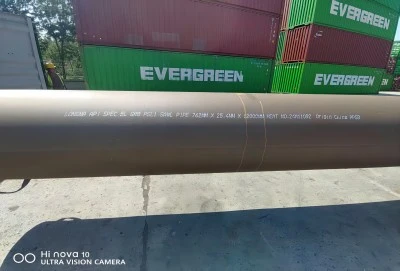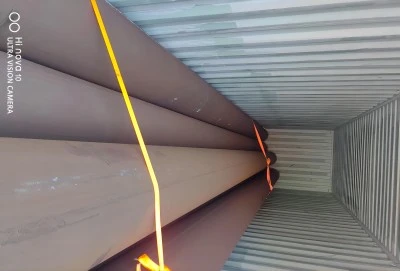When it comes to the oil and gas industry, the quality and reliability of pipelines are paramount. API pipes, which are manufactured according to the standards set by the American Petroleum Institute (API), play a crucial role in ensuring the safe and efficient transportation of oil and gas. In this comprehensive guide, we'll explore the various API grades of pipe, their mechanical properties, and the differences between API 5L PSL1 and PSL2 grades.
|
|
|
API Grades: From X42 to X80
API grades are designations that indicate the strength and quality of steel pipes used in the oil and gas industry. These grades range from X42 to X80, with the number representing the minimum yield strength of the pipe in thousands of pounds per square inch (psi). For example, an X42 pipe has a minimum yield strength of 42,000 psi, while an X80 pipe boasts a minimum yield strength of 80,000 psi.
The most commonly used API pipe grades include:
- X42
- X46
- X52
- X56
- X60
- X65
- X70
- X80
As the grade number increases, so does the strength of the pipe. Higher-grade pipes are typically used in more demanding applications where increased pressure resistance and durability are required. It's important to note that while higher grades offer greater strength, they may also be more challenging to weld and form, requiring specialized equipment and expertise.
The selection of an appropriate API grade depends on various factors, including the operating pressure, temperature, and environmental conditions of the pipeline project. Engineers must carefully consider these factors to ensure the chosen grade meets the specific requirements of the application while maintaining safety and efficiency.
Mechanical Properties of Different API Pipe Grades
The mechanical properties of API pipes are crucial in determining their performance and suitability for various applications. These properties include yield strength, tensile strength, and elongation. Let's take a closer look at how these properties vary across different API grades:
| API Grade | Minimum Yield Strength (psi) | Minimum Tensile Strength (psi) | Minimum Elongation (%) |
|---|---|---|---|
| X42 | 42,000 | 60,000 | 23 |
| X52 | 52,000 | 66,000 | 21 |
| X60 | 60,000 | 75,000 | 19 |
| X70 | 70,000 | 82,000 | 17 |
| X80 | 80,000 | 90,000 | 16 |
As we can see from the table, higher-grade pipes generally have increased yield and tensile strengths, allowing them to withstand greater pressures and loads. However, it's important to note that the minimum elongation percentage tends to decrease as the grade increases. This trade-off between strength and ductility is a key consideration when selecting the appropriate API grade for a specific application.
Yield strength is particularly important as it determines the point at which the pipe will begin to deform permanently under stress. Tensile strength, on the other hand, indicates the maximum stress the pipe can withstand before failure. The elongation percentage is a measure of the pipe's ductility, or its ability to deform plastically without fracturing.
In addition to these primary mechanical properties, API pipes are also evaluated for other characteristics such as:
- Toughness: The ability to absorb energy and deform plastically before fracturing
- Hardness: Resistance to indentation and wear
- Fatigue resistance: The ability to withstand repeated cyclic loading
- Corrosion resistance: Protection against environmental degradation
These properties are influenced by factors such as the chemical composition of the steel, heat treatment processes, and manufacturing techniques. Advanced metallurgical processes and quality control measures are employed to ensure that API pipes meet or exceed the required mechanical properties for each grade.
Comparison of API 5L PSL1 vs PSL2 Grades
API 5L is a specification that covers seamless and welded steel line pipes for use in conveying gas, water, and oil in both the oil and natural gas industries. Within this specification, there are two product specification levels (PSL): PSL1 and PSL2. Understanding the differences between these two levels is crucial for selecting the appropriate pipe for a given application.
API 5L PSL1:
- Represents the standard level of pipe quality
- Covers grades up to X70
- Has less stringent requirements for chemical composition and mechanical properties
- Typically used in less demanding applications or where cost is a primary consideration
- Allows for a wider range of manufacturing processes
API 5L PSL2:
- Represents a higher level of pipe quality with more stringent requirements
- Covers grades up to X80 and beyond
- Has tighter controls on chemical composition and mechanical properties
- Requires additional testing, including fracture toughness and through-thickness tensile testing
- Typically used in more critical applications where safety and reliability are paramount
- Often specified for offshore pipelines and high-pressure transmission lines
The main differences between PSL1 and PSL2 grades lie in the following areas:
- Chemical Composition: PSL2 has stricter limits on elements such as carbon, manganese, phosphorus, and sulfur, which contribute to improved weldability and toughness.
- Mechanical Properties: PSL2 requires tighter tolerances on yield strength, tensile strength, and the yield-to-tensile ratio.
- Testing Requirements: PSL2 mandates additional tests, including Charpy V-notch impact tests to ensure adequate toughness, and through-thickness tensile tests for larger diameter pipes.
- Quality Control: PSL2 requires more rigorous quality control procedures during manufacturing, including non-destructive testing of the entire pipe body.
- Traceability: PSL2 pipes must have enhanced traceability, with each pipe marked to allow identification of the specific heat of steel used in its production.
The choice between PSL1 and PSL2 grades depends on the specific requirements of the pipeline project. While PSL2 grades offer higher quality and reliability, they also come at a higher cost due to the additional manufacturing controls and testing required. Engineers must carefully weigh the benefits of PSL2 against the project budget and operational requirements when making their selection.
It's worth noting that some projects may specify a combination of PSL1 and PSL2 grades, using PSL2 for critical sections of the pipeline and PSL1 for less demanding areas. This approach can help optimize costs while still maintaining the necessary safety and performance standards.
Contact Longma
Understanding the various API grades of pipe is essential for anyone involved in the oil and gas industry or related fields. From the range of grades X42 to X80, each designation offers specific mechanical properties suited to different applications. The choice between API 5L PSL1 and PSL2 grades further refines the selection process, allowing engineers to balance quality, performance, and cost considerations.
As pipeline projects become increasingly complex and demanding, the importance of selecting the right API grade cannot be overstated. It's not just about meeting minimum standards; it's about ensuring the long-term safety, efficiency, and reliability of critical infrastructure.
For those seeking high-quality API pipes that meet the most stringent industry standards, Longma Group stands out as a leading manufacturer. With extensive experience in producing large-diameter, thick-walled, double-sided, sub-arc-seam welding steel pipes, including LSAW (Longitudinal Submerged Arc Welded) and ERW (Electric Resistance Welded) steel pipes, Longma Group has established itself as a trusted name in the industry. Their commitment to quality and impressive annual output of over 1,000,000 tons by the end of 2023 makes them an excellent choice for your pipeline needs. To learn more about how Longma Group can support your project with top-API grade pipes, don't hesitate to reach out to their team at info@longma-group.com.














